Stakeholders … the groups or individuals who


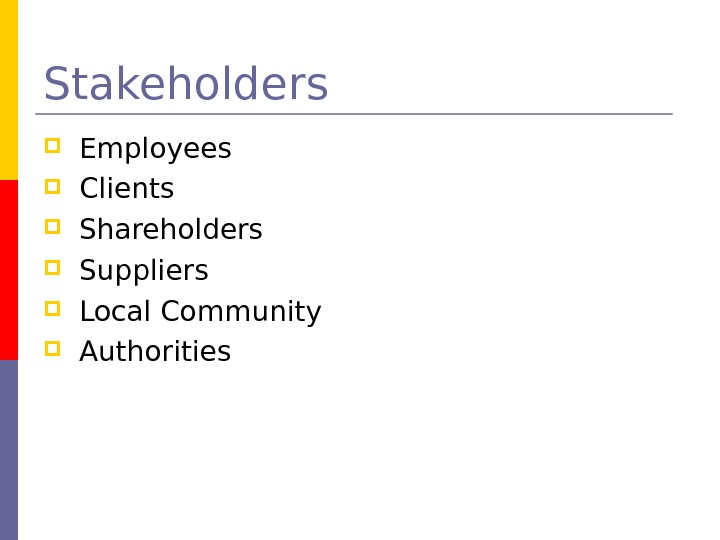
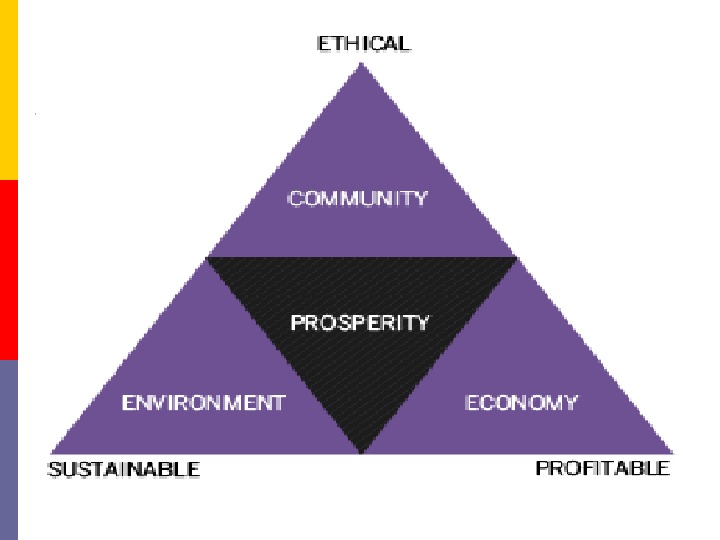
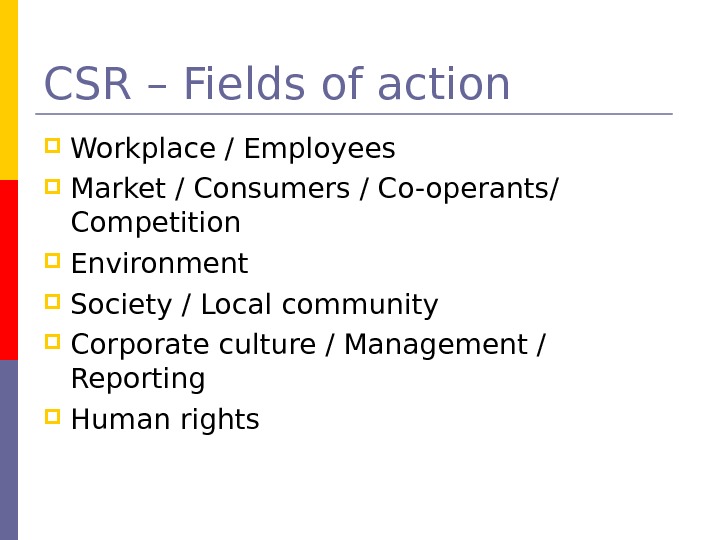
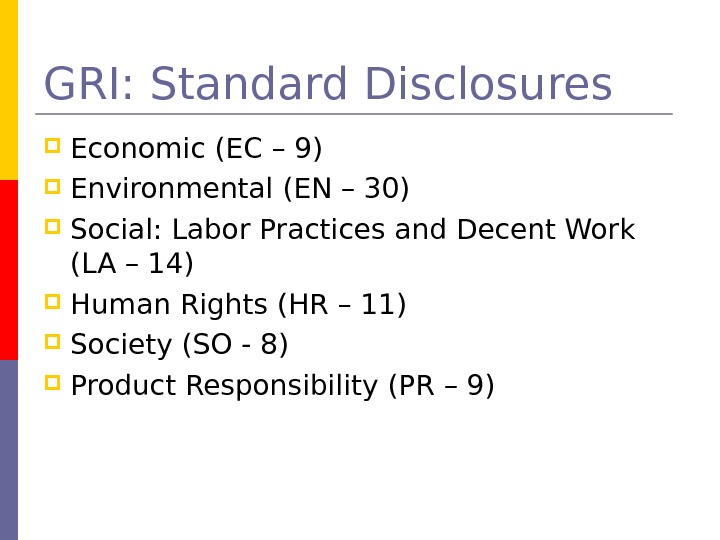
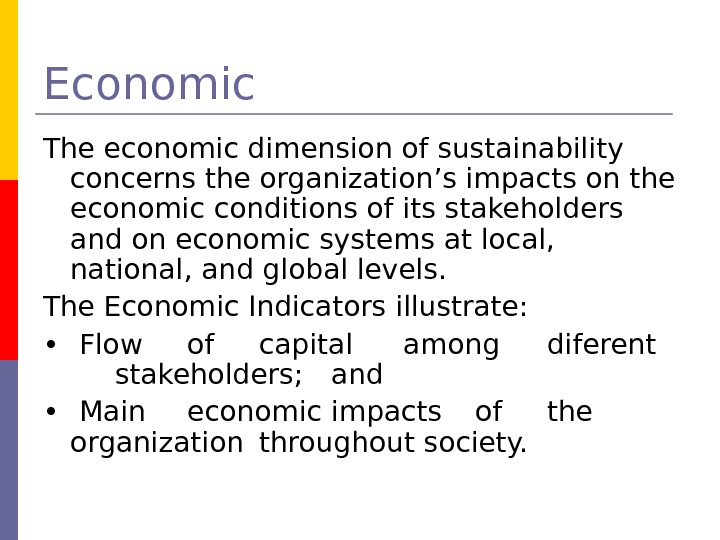
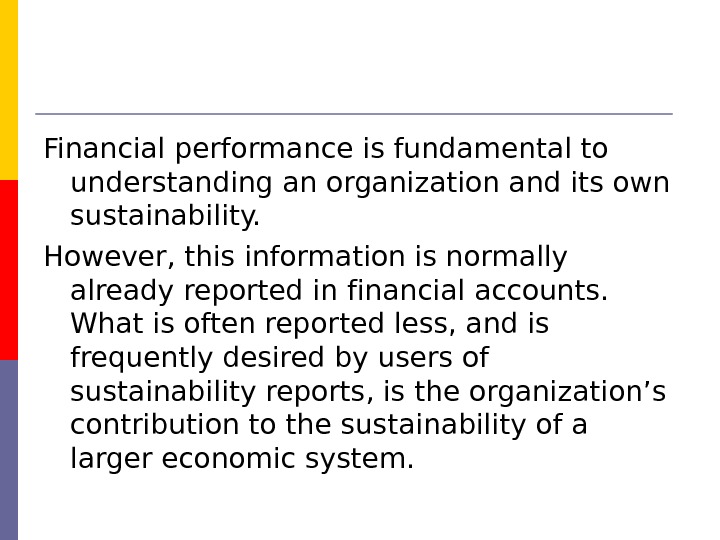
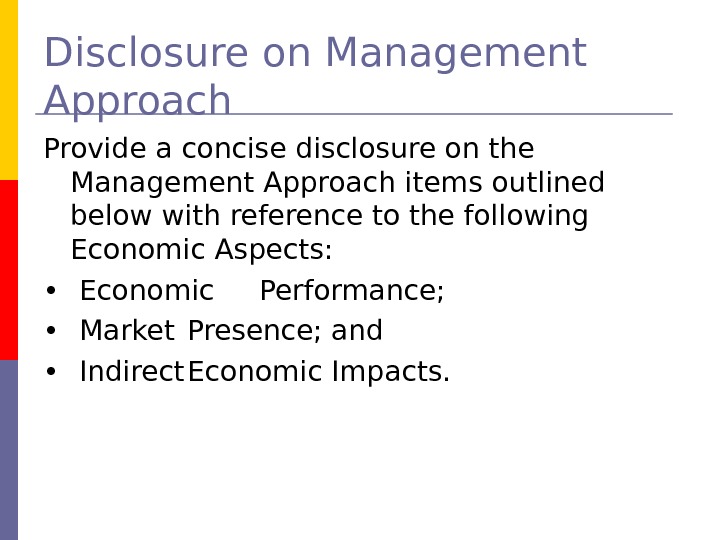
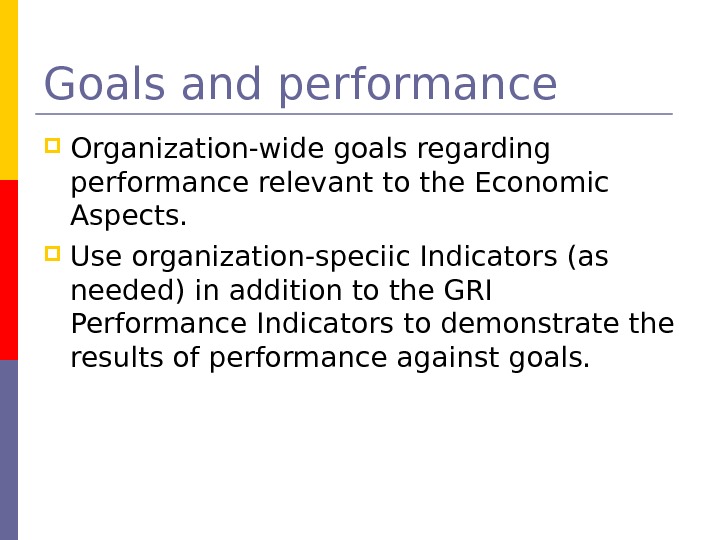
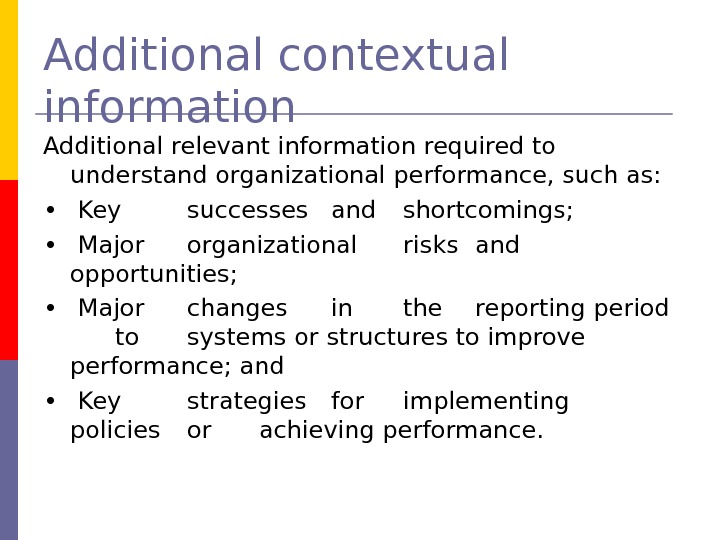
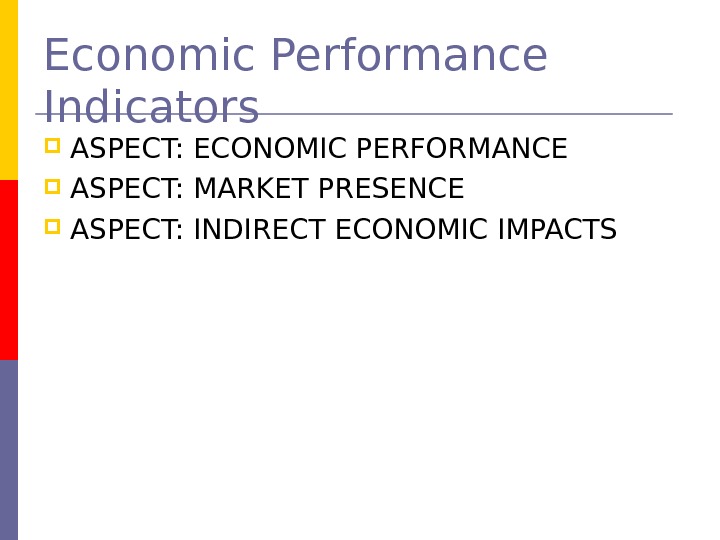
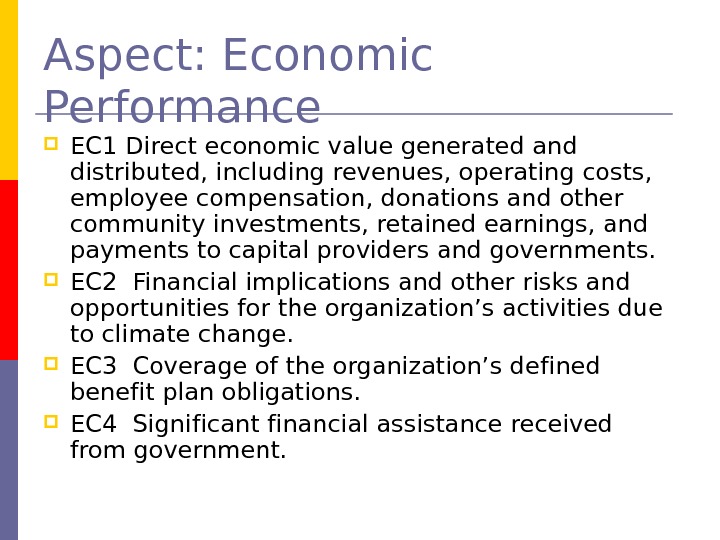
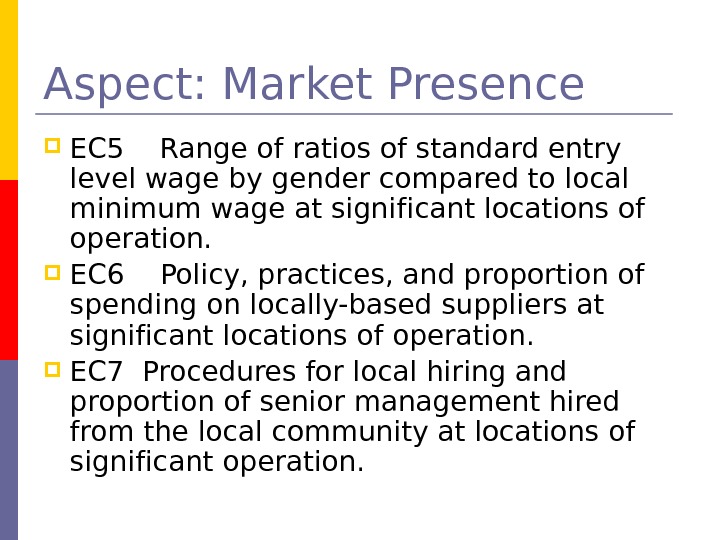
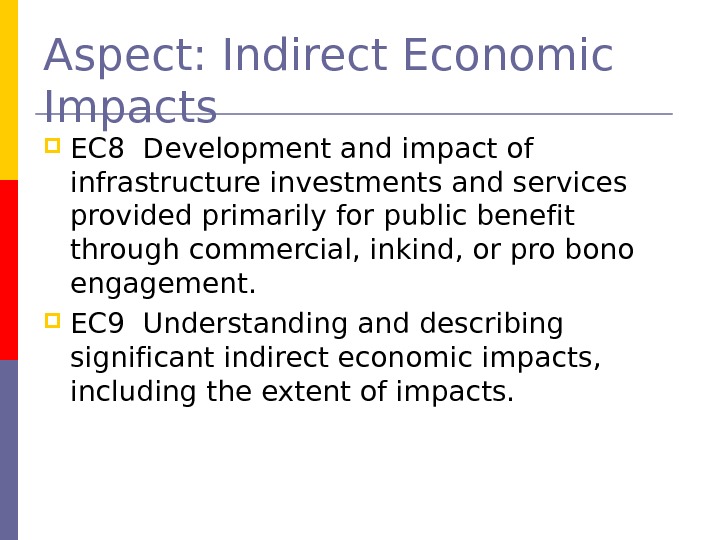
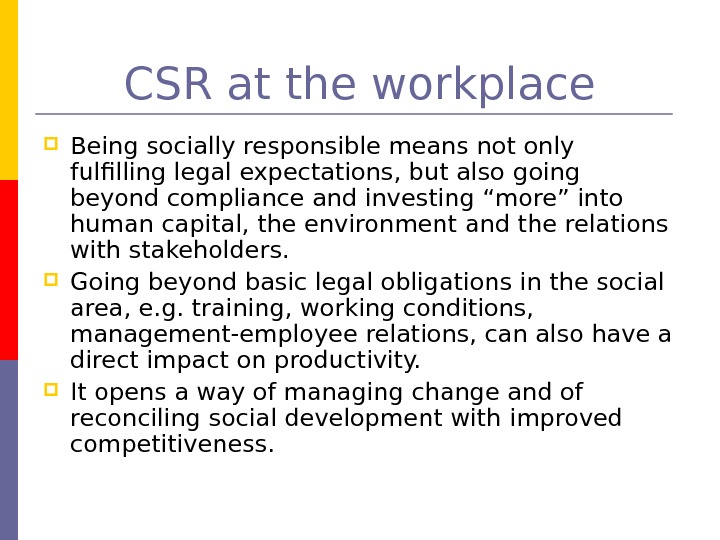
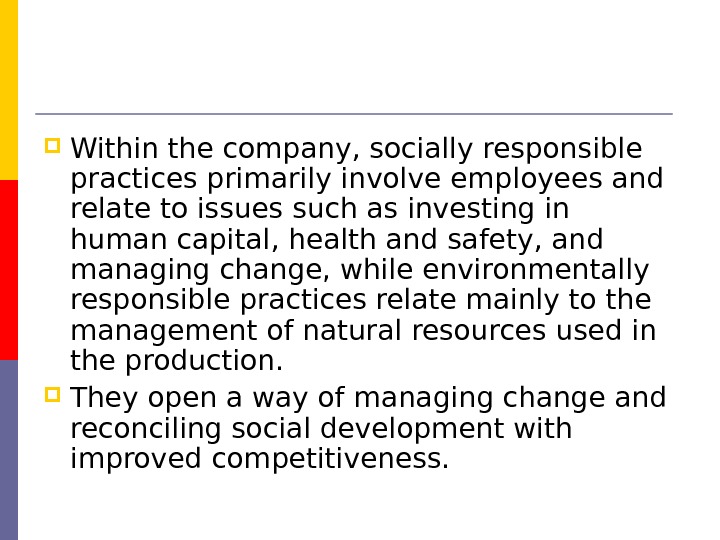

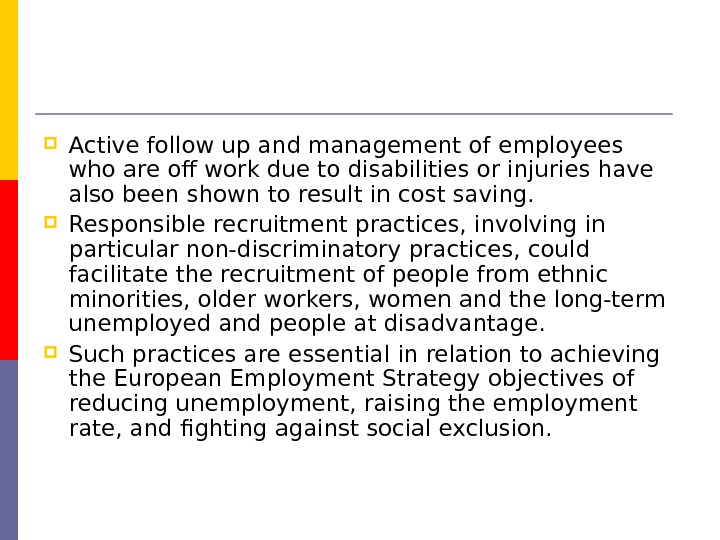

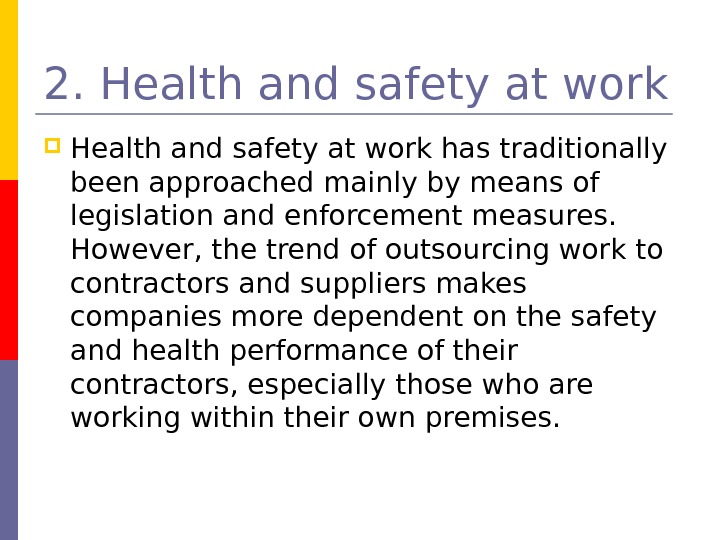
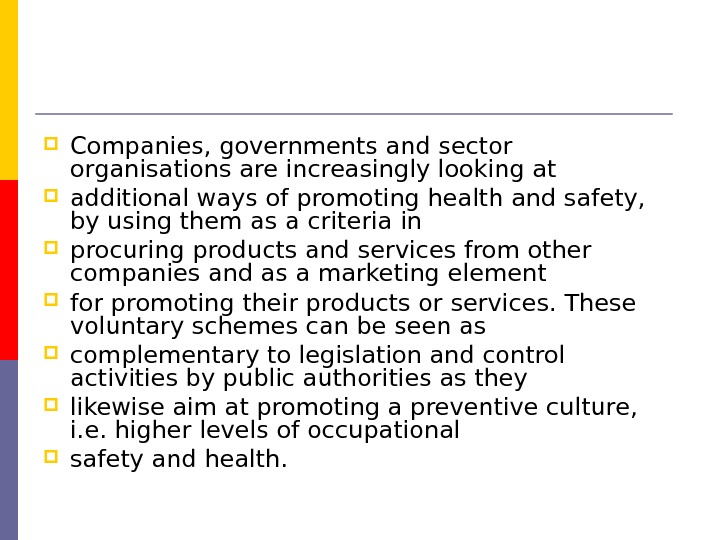

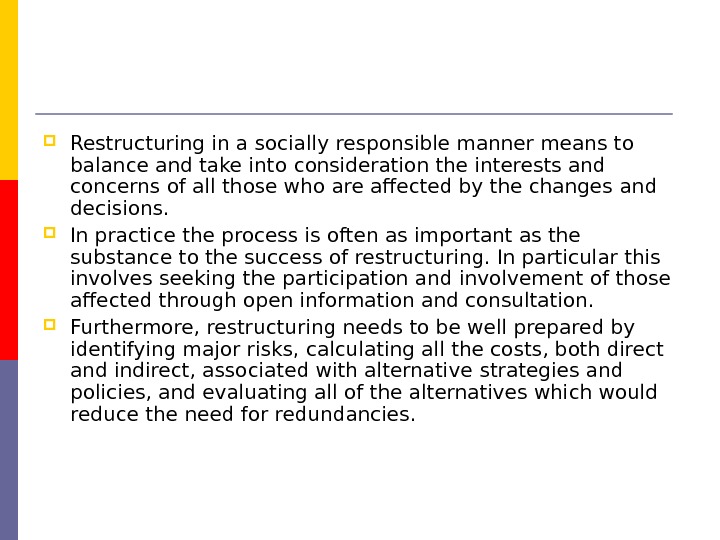
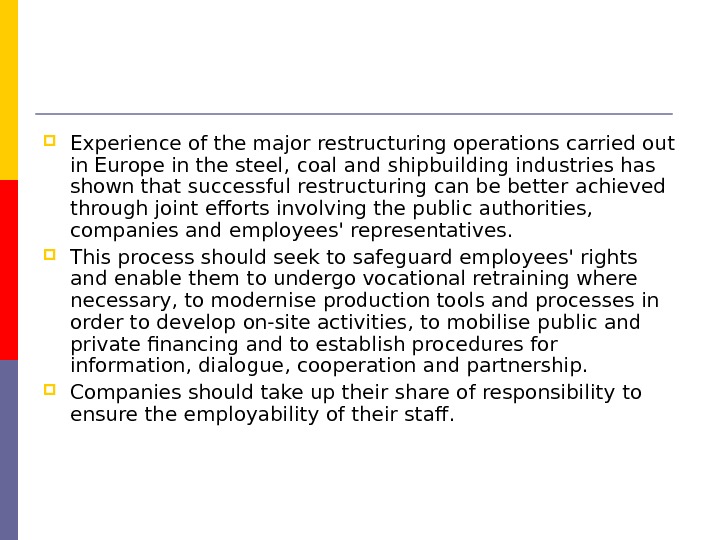
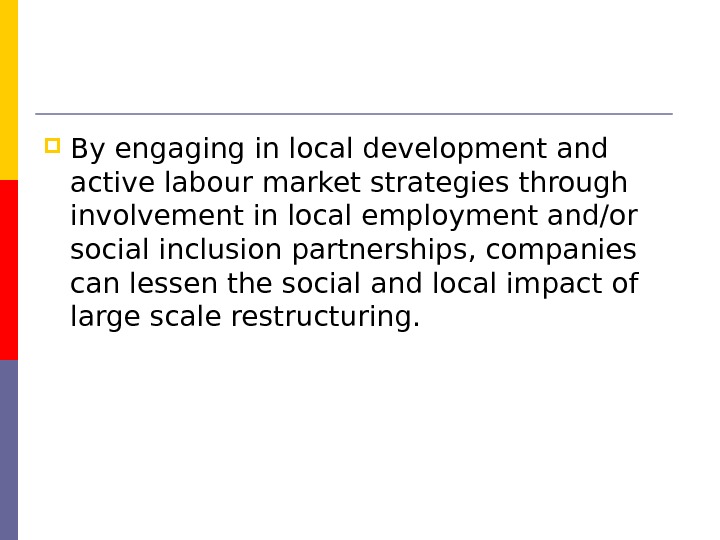
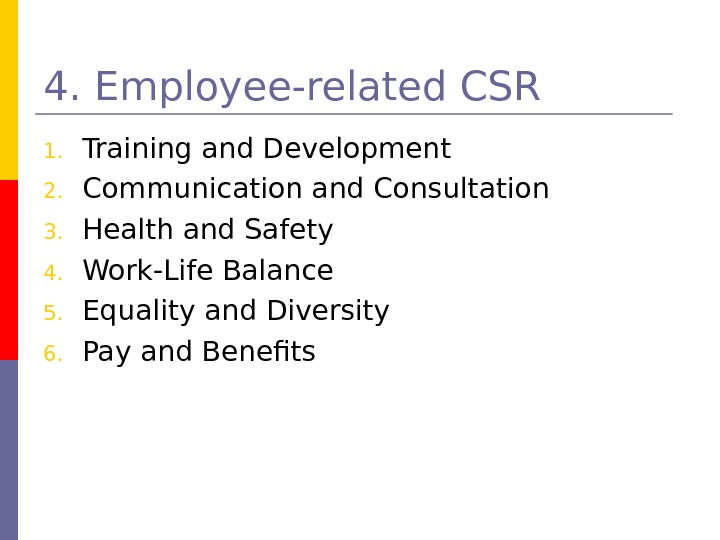
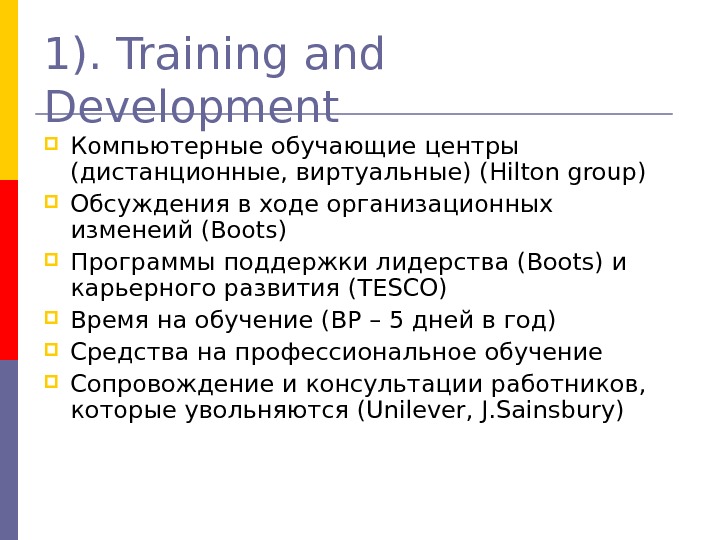
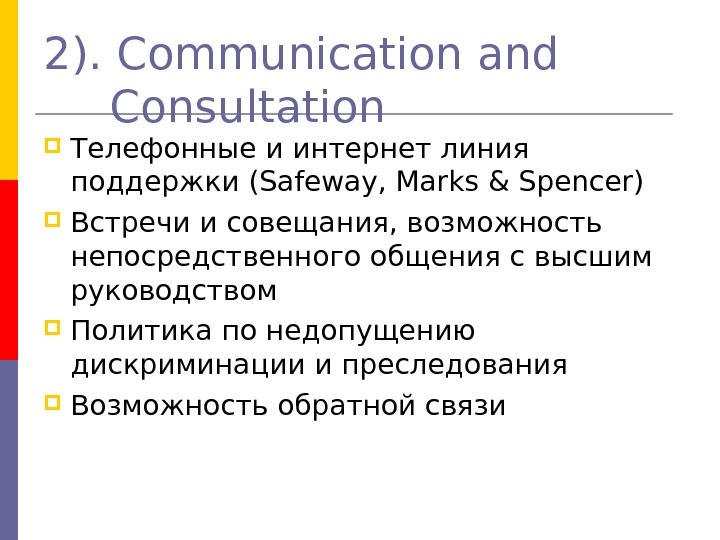
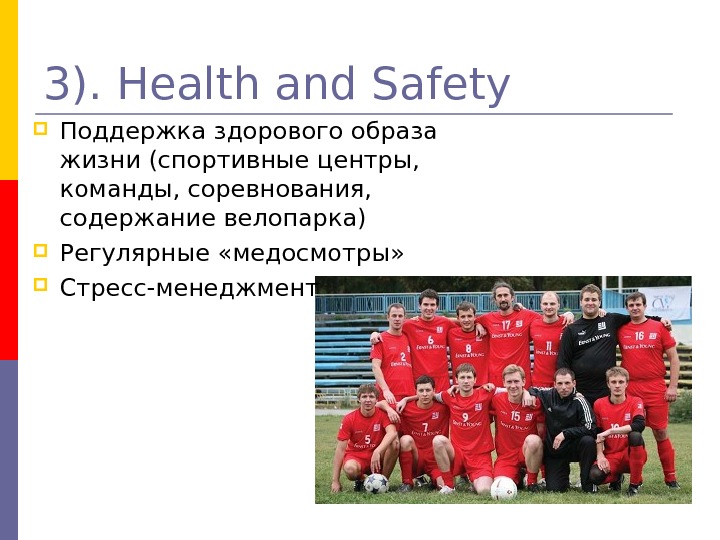

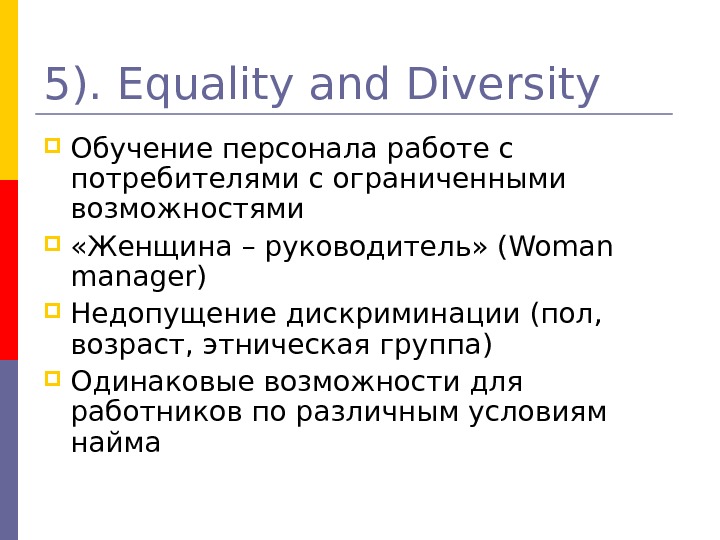

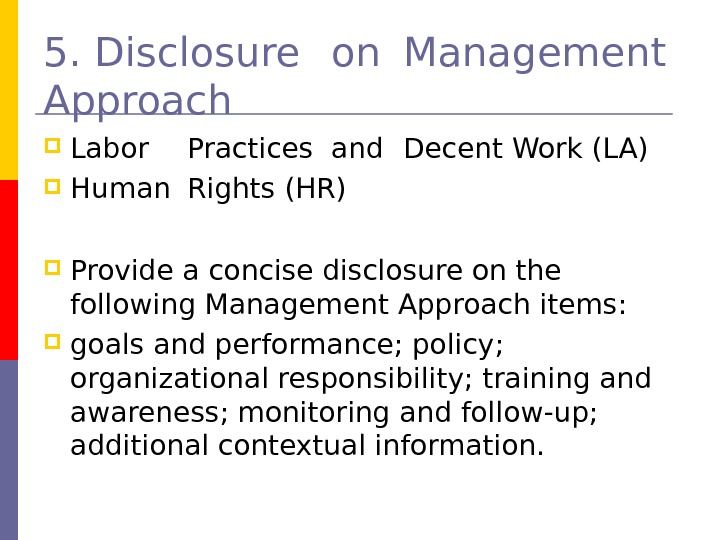
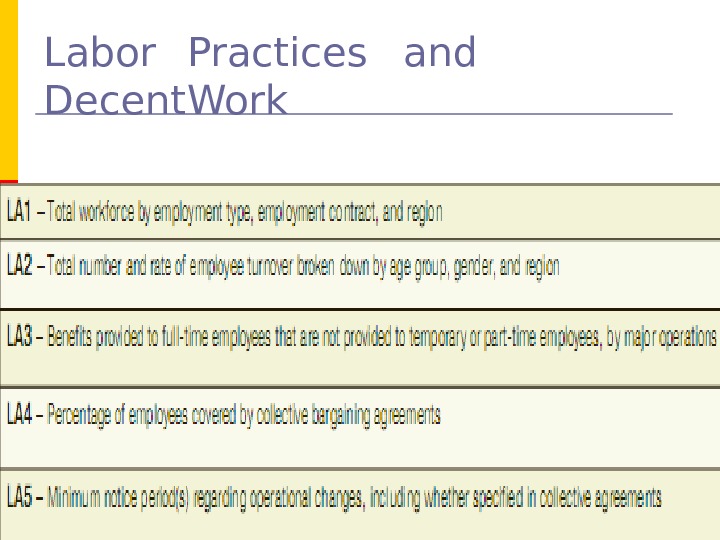


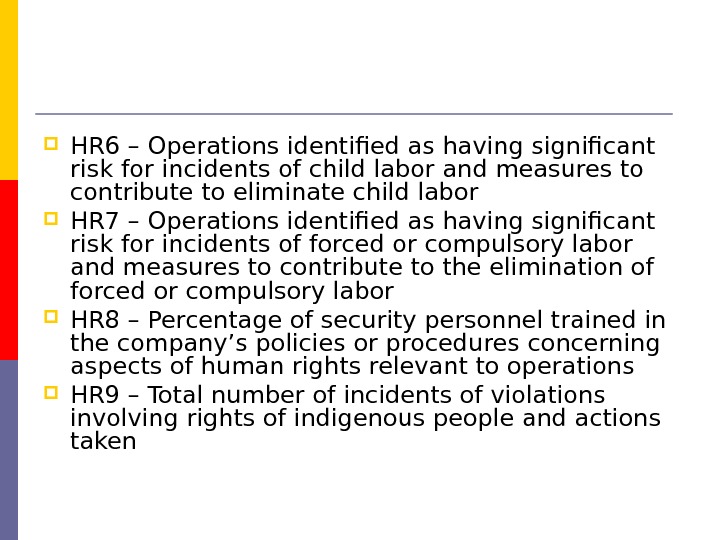

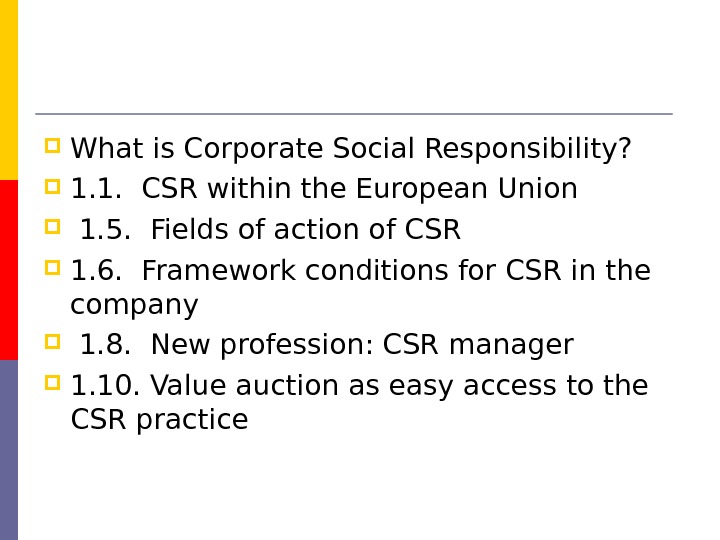
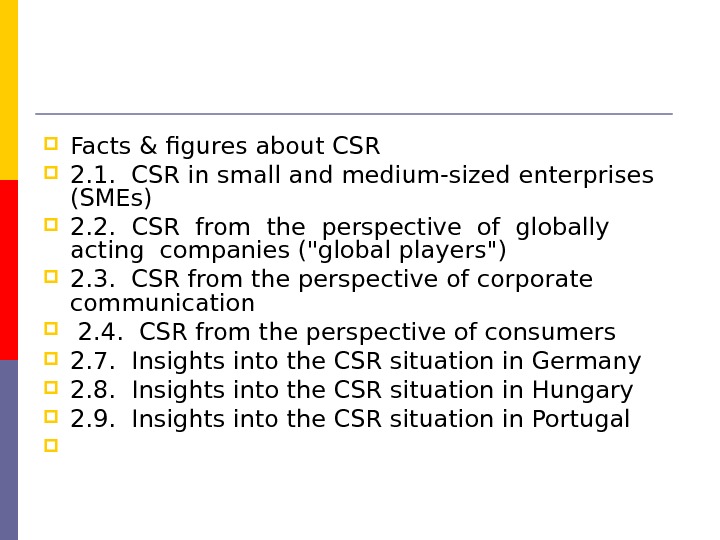
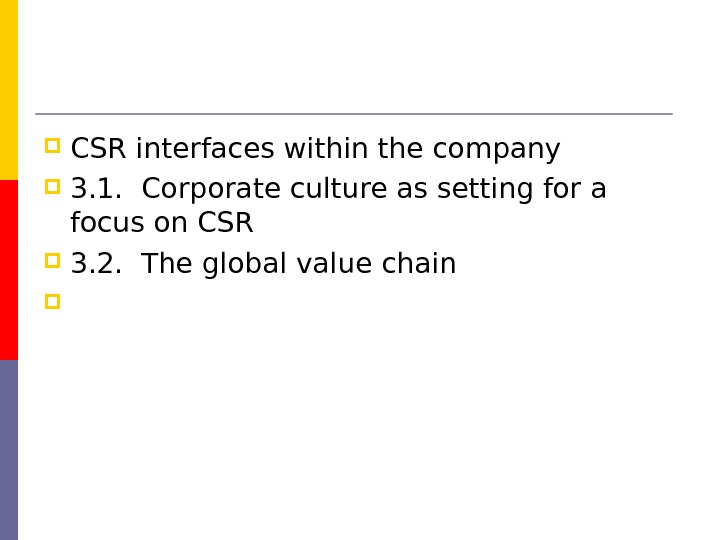
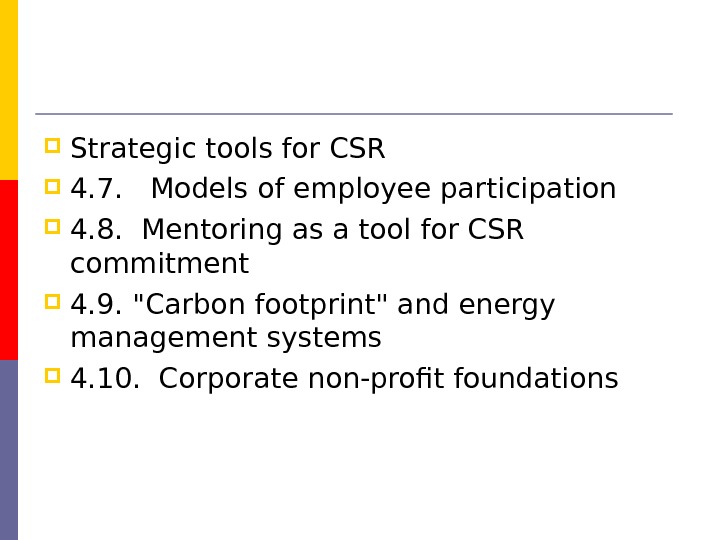

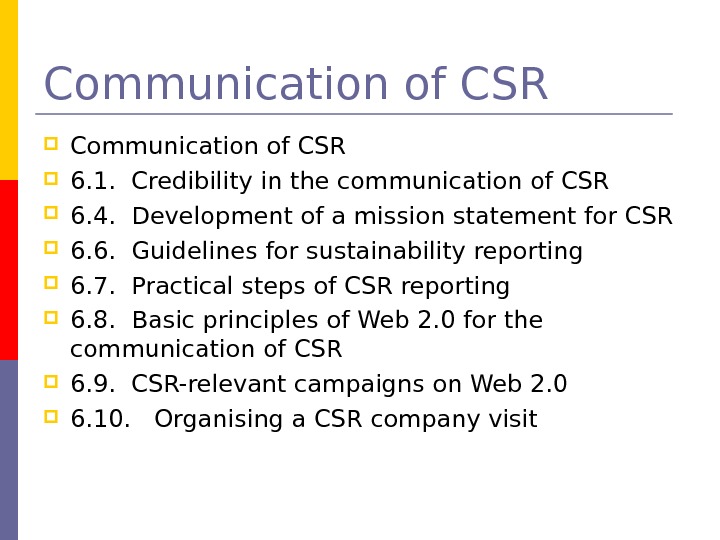

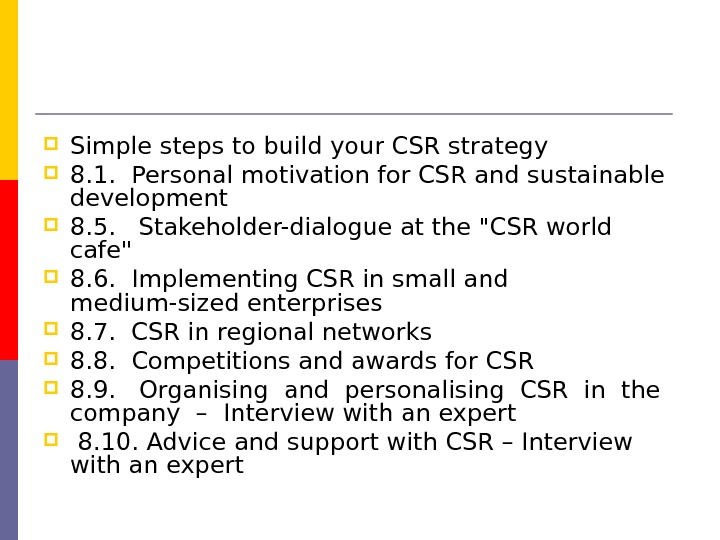
- Размер: 453.5 Кб
- Количество слайдов: 46
Описание презентации Stakeholders … the groups or individuals who по слайдам
 Stakeholders … the groups or individuals who are affected directly or indirectly by the operations of a company and who influence it as well
Stakeholders … the groups or individuals who are affected directly or indirectly by the operations of a company and who influence it as well
 Stakeholders Employees Clients Shareholders Suppliers Local Community Authorities
Stakeholders Employees Clients Shareholders Suppliers Local Community Authorities

 CSR – Fields of action Workplace / Employees Market / Consumers / Co-operants/ Competition Environment Society / Local community Corporate culture / Management / Reporting Human rights
CSR – Fields of action Workplace / Employees Market / Consumers / Co-operants/ Competition Environment Society / Local community Corporate culture / Management / Reporting Human rights
 GRI: Standard Disclosures Economic (EC – 9) Environmental (EN – 30) Social: Labor Practices and Decent Work (LA – 14) Human Rights (HR – 11) Society (SO — 8) Product Responsibility (PR – 9)
GRI: Standard Disclosures Economic (EC – 9) Environmental (EN – 30) Social: Labor Practices and Decent Work (LA – 14) Human Rights (HR – 11) Society (SO — 8) Product Responsibility (PR – 9)
 Economic The economic dimension of sustainability concerns the organization’s impacts on the economic conditions of its stakeholders and on economic systems at local, national, and global levels. The Economic Indicators illustrate: • Flow of capital among diferent stakeholders; and • Main economic impacts of the organization throughout society.
Economic The economic dimension of sustainability concerns the organization’s impacts on the economic conditions of its stakeholders and on economic systems at local, national, and global levels. The Economic Indicators illustrate: • Flow of capital among diferent stakeholders; and • Main economic impacts of the organization throughout society.
 Financial performance is fundamental to understanding an organization and its own sustainability. However, this information is normally already reported in f inancial accounts. What is often reported less, and is frequently desired by users of sustainability reports, is the organization’s contribution to the sustainability of a larger economic system.
Financial performance is fundamental to understanding an organization and its own sustainability. However, this information is normally already reported in f inancial accounts. What is often reported less, and is frequently desired by users of sustainability reports, is the organization’s contribution to the sustainability of a larger economic system.
 Disclosure on Management Approach Provide a concise disclosure on the Management Approach items outlined below with reference to the following Economic Aspects: • Economic Performance; • Market Presence; and • Indirect Economic Impacts.
Disclosure on Management Approach Provide a concise disclosure on the Management Approach items outlined below with reference to the following Economic Aspects: • Economic Performance; • Market Presence; and • Indirect Economic Impacts.
 Goals and performance Organization-wide goals regarding performance relevant to the Economic Aspects. Use organization-speciic Indicators (as needed) in addition to the GRI Performance Indicators to demonstrate the results of performance against goals.
Goals and performance Organization-wide goals regarding performance relevant to the Economic Aspects. Use organization-speciic Indicators (as needed) in addition to the GRI Performance Indicators to demonstrate the results of performance against goals.
 Additional contextual information Additional relevant information required to understand organizational performance, such as: • Key successes and shortcomings; • Major organizational risks and opportunities; • Major changes in the reporting period to systems or structures to improve performance; and • Key strategies for implementing policies or achieving performance.
Additional contextual information Additional relevant information required to understand organizational performance, such as: • Key successes and shortcomings; • Major organizational risks and opportunities; • Major changes in the reporting period to systems or structures to improve performance; and • Key strategies for implementing policies or achieving performance.
 Economic Performance Indicators ASPECT: ECONOMIC PERFORMANCE ASPECT: MARKET PRESENCE ASPECT: INDIRECT ECONOMIC IMPACTS
Economic Performance Indicators ASPECT: ECONOMIC PERFORMANCE ASPECT: MARKET PRESENCE ASPECT: INDIRECT ECONOMIC IMPACTS
 Aspect: Economic Performance EC 1 Direct economic value generated and distributed, including revenues, operating costs, employee compensation, donations and other community investments, retained earnings, and payments to capital providers and governments. EC 2 Financial implications and other risks and opportunities for the organization’s activities due to climate change. EC 3 Coverage of the organization’s de f ined bene f it plan obligations. EC 4 Signi f icant f inancial assistance received f rom government.
Aspect: Economic Performance EC 1 Direct economic value generated and distributed, including revenues, operating costs, employee compensation, donations and other community investments, retained earnings, and payments to capital providers and governments. EC 2 Financial implications and other risks and opportunities for the organization’s activities due to climate change. EC 3 Coverage of the organization’s de f ined bene f it plan obligations. EC 4 Signi f icant f inancial assistance received f rom government.
 Aspect: Market Presence EC 5 Range of ratios of standard entry level wage by gender compared to local minimum wage at signi f icant locations of operation. EC 6 Policy, practices, and proportion of spending on locally-based suppliers at signi f icant locations of operation. EC 7 Procedures for local hiring and proportion of senior management hired from the local community at locations of signi f icant operation.
Aspect: Market Presence EC 5 Range of ratios of standard entry level wage by gender compared to local minimum wage at signi f icant locations of operation. EC 6 Policy, practices, and proportion of spending on locally-based suppliers at signi f icant locations of operation. EC 7 Procedures for local hiring and proportion of senior management hired from the local community at locations of signi f icant operation.
 Aspect: Indirect Economic Impacts EC 8 Development and impact of infrastructure investments and services provided primarily for public bene f it through commercial, inkind, or pro bono engagement. EC 9 Understanding and describing signi f icant indirect economic impacts, including the extent of impacts.
Aspect: Indirect Economic Impacts EC 8 Development and impact of infrastructure investments and services provided primarily for public bene f it through commercial, inkind, or pro bono engagement. EC 9 Understanding and describing signi f icant indirect economic impacts, including the extent of impacts.
 CSR at the workplace Being socially responsible means not only fulfilling legal expectations, but also going beyond compliance and investing “more” into human capital, the environment and the relations with stakeholders. Going beyond basic legal obligations in the social area, e. g. training, working conditions, management-employee relations, can also have a direct impact on productivity. It opens a way of managing change and of reconciling social development with improved competitiveness.
CSR at the workplace Being socially responsible means not only fulfilling legal expectations, but also going beyond compliance and investing “more” into human capital, the environment and the relations with stakeholders. Going beyond basic legal obligations in the social area, e. g. training, working conditions, management-employee relations, can also have a direct impact on productivity. It opens a way of managing change and of reconciling social development with improved competitiveness.
 Within the company, socially responsible practices primarily involve employees and relate to issues such as investing in human capital, health and safety, and managing change, while environmentally responsible practices relate mainly to the management of natural resources used in the production. They open a way of managing change and reconciling social development with improved competitiveness.
Within the company, socially responsible practices primarily involve employees and relate to issues such as investing in human capital, health and safety, and managing change, while environmentally responsible practices relate mainly to the management of natural resources used in the production. They open a way of managing change and reconciling social development with improved competitiveness.
 1. Human resources management A major challenge for enterprises today is to attract and retain skilled workers. R elevant measures could include life long learning, empowerment of employees, better information throughout the company, better balance between work, family, and leisure, greater work force diversity, equal pay and career prospects for women, profit sharing and share ownership schemes, and concern for employability as well as job security.
1. Human resources management A major challenge for enterprises today is to attract and retain skilled workers. R elevant measures could include life long learning, empowerment of employees, better information throughout the company, better balance between work, family, and leisure, greater work force diversity, equal pay and career prospects for women, profit sharing and share ownership schemes, and concern for employability as well as job security.
 Active follow up and management of employees who are off work due to disabilities or injuries have also been shown to result in cost saving. Responsible recruitment practices, involving in particular non-discriminatory practices, could facilitate the recruitment of people from ethnic minorities, older workers, women and the long-term unemployed and people at disadvantage. Such practices are essential in relation to achieving the European Employment Strategy objectives of reducing unemployment, raising the employment rate, and fighting against social exclusion.
Active follow up and management of employees who are off work due to disabilities or injuries have also been shown to result in cost saving. Responsible recruitment practices, involving in particular non-discriminatory practices, could facilitate the recruitment of people from ethnic minorities, older workers, women and the long-term unemployed and people at disadvantage. Such practices are essential in relation to achieving the European Employment Strategy objectives of reducing unemployment, raising the employment rate, and fighting against social exclusion.

 2. Health and safety at work has traditionally been approached mainly by means of legislation and enforcement measures. However, the trend of outsourcing work to contractors and suppliers makes companies more dependent on the safety and health performance of their contractors, especially those who are working within their own premises.
2. Health and safety at work has traditionally been approached mainly by means of legislation and enforcement measures. However, the trend of outsourcing work to contractors and suppliers makes companies more dependent on the safety and health performance of their contractors, especially those who are working within their own premises.
 Companies, governments and sector organisations are increasingly looking at additional ways of promoting health and safety, by using them as a criteria in procuring products and services from other companies and as a marketing element for promoting their products or services. These voluntary schemes can be seen as complementary to legislation and control activities by public authorities as they likewise aim at promoting a preventive culture, i. e. higher levels of occupational safety and health.
Companies, governments and sector organisations are increasingly looking at additional ways of promoting health and safety, by using them as a criteria in procuring products and services from other companies and as a marketing element for promoting their products or services. These voluntary schemes can be seen as complementary to legislation and control activities by public authorities as they likewise aim at promoting a preventive culture, i. e. higher levels of occupational safety and health.
 3. Adaptation to change The widespread restructuring taking place in Europe raises concerns for all of the employees and other stakeholders as the closure of a factory or a heavy cut in its workforce may involve a serious economic, social or political crisis in a community. Few companies escape the need to restructure, often through downsizing, with the year 2000 seeing more mergers and acquisitions than any other year in history. According to one study, fewer than one in four restructuring operations achieve their objectives of reducing costs, increasing productivity and improving quality and customer service as they often cause the motivation, loyalty, creativity and productivity of the employees to suffer.
3. Adaptation to change The widespread restructuring taking place in Europe raises concerns for all of the employees and other stakeholders as the closure of a factory or a heavy cut in its workforce may involve a serious economic, social or political crisis in a community. Few companies escape the need to restructure, often through downsizing, with the year 2000 seeing more mergers and acquisitions than any other year in history. According to one study, fewer than one in four restructuring operations achieve their objectives of reducing costs, increasing productivity and improving quality and customer service as they often cause the motivation, loyalty, creativity and productivity of the employees to suffer.
 Restructuring in a socially responsible manner means to balance and take into consideration the interests and concerns of all those who are affected by the changes and decisions. In practice the process is often as important as the substance to the success of restructuring. In particular this involves seeking the participation and involvement of those affected through open information and consultation. Furthermore, restructuring needs to be well prepared by identifying major risks, calculating all the costs, both direct and indirect, associated with alternative strategies and policies, and evaluating all of the alternatives which would reduce the need for redundancies.
Restructuring in a socially responsible manner means to balance and take into consideration the interests and concerns of all those who are affected by the changes and decisions. In practice the process is often as important as the substance to the success of restructuring. In particular this involves seeking the participation and involvement of those affected through open information and consultation. Furthermore, restructuring needs to be well prepared by identifying major risks, calculating all the costs, both direct and indirect, associated with alternative strategies and policies, and evaluating all of the alternatives which would reduce the need for redundancies.
 Experience of the major restructuring operations carried out in Europe in the steel, coal and shipbuilding industries has shown that successful restructuring can be better achieved through joint efforts involving the public authorities, companies and employees’ representatives. This process should seek to safeguard employees’ rights and enable them to undergo vocational retraining where necessary, to modernise production tools and processes in order to develop on-site activities, to mobilise public and private financing and to establish procedures for information, dialogue, cooperation and partnership. Companies should take up their share of responsibility to ensure the employability of their staff.
Experience of the major restructuring operations carried out in Europe in the steel, coal and shipbuilding industries has shown that successful restructuring can be better achieved through joint efforts involving the public authorities, companies and employees’ representatives. This process should seek to safeguard employees’ rights and enable them to undergo vocational retraining where necessary, to modernise production tools and processes in order to develop on-site activities, to mobilise public and private financing and to establish procedures for information, dialogue, cooperation and partnership. Companies should take up their share of responsibility to ensure the employability of their staff.
 By engaging in local development and active labour market strategies through involvement in local employment and/or social inclusion partnerships, companies can lessen the social and local impact of large scale restructuring.
By engaging in local development and active labour market strategies through involvement in local employment and/or social inclusion partnerships, companies can lessen the social and local impact of large scale restructuring.
 4. Employee-related CSR 1. Training and Development 2. Communication and Consultation 3. Health and Safety 4. Work-Life Balance 5. Equality and Diversity 6. Pay and Benefits
4. Employee-related CSR 1. Training and Development 2. Communication and Consultation 3. Health and Safety 4. Work-Life Balance 5. Equality and Diversity 6. Pay and Benefits
 1 ). Training and Development Компьютерные обучающие центры ( дистанционные, виртуальные) ( Hilton group ) Обсуждения в ходе организационных изменеий (Boots) Программы поддержки лидерства ( Boots) и карьерного развития ( TESCO) Время на обучение ( BP – 5 дней в год) Средства на профессиональное обучение Сопровождение и консультации работников, которые увольняются ( Unilever, J. Sain s bury)
1 ). Training and Development Компьютерные обучающие центры ( дистанционные, виртуальные) ( Hilton group ) Обсуждения в ходе организационных изменеий (Boots) Программы поддержки лидерства ( Boots) и карьерного развития ( TESCO) Время на обучение ( BP – 5 дней в год) Средства на профессиональное обучение Сопровождение и консультации работников, которые увольняются ( Unilever, J. Sain s bury)
 2 ). Communication and Consultation Телефонн ые и интернет линия поддержки (Safeway, Marks & Spencer) Встречи и совещания, возможность непосредственного общения с высшим руководством Политика по недопущению дискриминации и преследования Возможность обратной связи
2 ). Communication and Consultation Телефонн ые и интернет линия поддержки (Safeway, Marks & Spencer) Встречи и совещания, возможность непосредственного общения с высшим руководством Политика по недопущению дискриминации и преследования Возможность обратной связи
 3 ). Health and Safety Поддержка здорового образа жизни (спортивные центры, команды, соревнования, содержание велопарка) Регулярные «медосмотры» Стресс-менеджмент
3 ). Health and Safety Поддержка здорового образа жизни (спортивные центры, команды, соревнования, содержание велопарка) Регулярные «медосмотры» Стресс-менеджмент
 4 ). Work-Life Balance «Гибкий» рабочий график Схема поддержки матерей «Карьерные» перерывы (даже до 6 мес. )
4 ). Work-Life Balance «Гибкий» рабочий график Схема поддержки матерей «Карьерные» перерывы (даже до 6 мес. )
 5 ). Equality and Diversity Обучение персонала работе с потребителями с ограниченными возможностями «Женщина – руководитель» ( Woman manager) Недопущение дискриминации (пол, возраст, этническая группа) Одинаковые возможности для работников по различным условиям найма
5 ). Equality and Diversity Обучение персонала работе с потребителями с ограниченными возможностями «Женщина – руководитель» ( Woman manager) Недопущение дискриминации (пол, возраст, этническая группа) Одинаковые возможности для работников по различным условиям найма
 6 ). Pay and Benefits Поддержка молодых матерей Возможность приобретения (и получения бесплатно) акций компаний Бесплатная медицинская страховка Скидки для работников и их родственников
6 ). Pay and Benefits Поддержка молодых матерей Возможность приобретения (и получения бесплатно) акций компаний Бесплатная медицинская страховка Скидки для работников и их родственников
 5. Disclosure on Management Approach Labor Practices and Decent Work (LA) H uman Rights (HR) Provide a concise disclosure on the following Management Approach items: goals and performance; policy; organizational responsibility; training and awareness; monitoring and follow-up; additional contextual information.
5. Disclosure on Management Approach Labor Practices and Decent Work (LA) H uman Rights (HR) Provide a concise disclosure on the following Management Approach items: goals and performance; policy; organizational responsibility; training and awareness; monitoring and follow-up; additional contextual information.
 Labor Practices and Decent Work
Labor Practices and Decent Work

 Human Rights HR 1 – Percentage and total number of significant investment agreements that include human rights clauses or that underwent human rights screening HR 2 – Percentage of significant suppliers and contractors that underwent screening on human rights and actions taken HR 3 – Total hours of employee training on policies and procedures concerning aspects of human rights that are relevant to operations, including the percentage of employees trained HR 4 – Total number of incidents of discrimination and actions taken HR 5 – Operations identified where the right to exercise freedom of association and collective bargaining may be at significant risk, and actions to support these rights
Human Rights HR 1 – Percentage and total number of significant investment agreements that include human rights clauses or that underwent human rights screening HR 2 – Percentage of significant suppliers and contractors that underwent screening on human rights and actions taken HR 3 – Total hours of employee training on policies and procedures concerning aspects of human rights that are relevant to operations, including the percentage of employees trained HR 4 – Total number of incidents of discrimination and actions taken HR 5 – Operations identified where the right to exercise freedom of association and collective bargaining may be at significant risk, and actions to support these rights
 HR 6 – Operations identified as having significant risk for incidents of child labor and measures to contribute to eliminate child labor HR 7 – Operations identified as having significant risk for incidents of forced or compulsory labor and measures to contribute to the elimination of forced or compulsory labor HR 8 – Percentage of security personnel trained in the company’s policies or procedures concerning aspects of human rights relevant to operations HR 9 – Total number of incidents of violations involving rights of indigenous people and actions taken
HR 6 – Operations identified as having significant risk for incidents of child labor and measures to contribute to eliminate child labor HR 7 – Operations identified as having significant risk for incidents of forced or compulsory labor and measures to contribute to the elimination of forced or compulsory labor HR 8 – Percentage of security personnel trained in the company’s policies or procedures concerning aspects of human rights relevant to operations HR 9 – Total number of incidents of violations involving rights of indigenous people and actions taken
 Increased Ability to Attract, Motivate, and Retain Employees a company’s participation in social initiatives can have a positive impact on prospective and current employees, as well as citizens and executives Employees working in companies reported to have cause-related programs were 38% more likely to say they are proud of their company’s values than were employees in companies not reported to have these programs Even before 9/11, 48 percent of respondents indicated that a company’s commitment to causes is important when deciding where to work. After 9/11, that percentage rose to 76 … more than half of the 2, 100 MBA students surveyed indicated they would accept a lower salary in order to work for a socially responsible company … graduates look for the right corporate culture, as well as the right salary, job description, and opportunities for promotion
Increased Ability to Attract, Motivate, and Retain Employees a company’s participation in social initiatives can have a positive impact on prospective and current employees, as well as citizens and executives Employees working in companies reported to have cause-related programs were 38% more likely to say they are proud of their company’s values than were employees in companies not reported to have these programs Even before 9/11, 48 percent of respondents indicated that a company’s commitment to causes is important when deciding where to work. After 9/11, that percentage rose to 76 … more than half of the 2, 100 MBA students surveyed indicated they would accept a lower salary in order to work for a socially responsible company … graduates look for the right corporate culture, as well as the right salary, job description, and opportunities for promotion
 What is Corporate Social Responsibility? 1. 1. CSR within the European Union 1. 5. Fields of action of CSR 1. 6. Framework conditions for CSR in the company 1. 8. New profession: CSR manager 1. 10. Value auction as easy access to the CSR practice
What is Corporate Social Responsibility? 1. 1. CSR within the European Union 1. 5. Fields of action of CSR 1. 6. Framework conditions for CSR in the company 1. 8. New profession: CSR manager 1. 10. Value auction as easy access to the CSR practice
 Facts & figures about CSR 2. 1. CSR in small and medium-sized enterprises (SMEs) 2. 2. CSR from the perspective of globally acting companies («global players») 2. 3. CSR from the perspective of corporate communication 2. 4. CSR from the perspective of consumers 2. 7. Insights into the CSR situation in Germany 2. 8. Insights into the CSR situation in Hungary 2. 9. Insights into the CSR situation in Portugal
Facts & figures about CSR 2. 1. CSR in small and medium-sized enterprises (SMEs) 2. 2. CSR from the perspective of globally acting companies («global players») 2. 3. CSR from the perspective of corporate communication 2. 4. CSR from the perspective of consumers 2. 7. Insights into the CSR situation in Germany 2. 8. Insights into the CSR situation in Hungary 2. 9. Insights into the CSR situation in Portugal
 CSR interfaces within the company 3. 1. Corporate culture as setting for a focus on CSR 3. 2. The global value chain
CSR interfaces within the company 3. 1. Corporate culture as setting for a focus on CSR 3. 2. The global value chain
 Strategic tools for CSR 4. 7. Models of employee participation 4. 8. Mentoring as a tool for CSR commitment 4. 9. «Carbon footprint» and energy management systems 4. 10. Corporate non-profit foundations
Strategic tools for CSR 4. 7. Models of employee participation 4. 8. Mentoring as a tool for CSR commitment 4. 9. «Carbon footprint» and energy management systems 4. 10. Corporate non-profit foundations
 Fields of action of CSR 5. 1. CSR at the workplace 5. 2. Corporate Volunteering as an honorary commitment 5. 3. CSR as market parameter 5. 4. CSR in community structures – from the perspective of companies 5. 5. CSR in community structures – from the perspective of communities 5. 6. CSR and sustainability in the discourse on innovation 5. 7. CSR in risk management 5. 8. CSR and development cooperation 5. 9. CSR and Public Private Partnership 5. 10. Ethical dilemma: CSR in a market situation
Fields of action of CSR 5. 1. CSR at the workplace 5. 2. Corporate Volunteering as an honorary commitment 5. 3. CSR as market parameter 5. 4. CSR in community structures – from the perspective of companies 5. 5. CSR in community structures – from the perspective of communities 5. 6. CSR and sustainability in the discourse on innovation 5. 7. CSR in risk management 5. 8. CSR and development cooperation 5. 9. CSR and Public Private Partnership 5. 10. Ethical dilemma: CSR in a market situation
 Communication of CSR 6. 1. Credibility in the communication of CSR 6. 4. Development of a mission statement for CSR 6. 6. Guidelines for sustainability reporting 6. 7. Practical steps of CSR reporting 6. 8. Basic principles of Web 2. 0 for the communication of CSR 6. 9. CSR-relevant campaigns on Web 2. 0 6. 10. Organising a CSR company visit
Communication of CSR 6. 1. Credibility in the communication of CSR 6. 4. Development of a mission statement for CSR 6. 6. Guidelines for sustainability reporting 6. 7. Practical steps of CSR reporting 6. 8. Basic principles of Web 2. 0 for the communication of CSR 6. 9. CSR-relevant campaigns on Web 2. 0 6. 10. Organising a CSR company visit
 Best practice examples of CSR 7. 1. Hanning & Kahl – Video: CSR at the workplace 7. 2. Praktiker Hungary – Video: CSR in the market 7. 3. Valorsul – Video: CSR and the environment 7. 4. Pritchard Englefield – Video: CSR in the community 7. 5. Case study: Baufritz 7. 6. Case study: Gelpeixe 7. 7. Case study: Inno. Dämm 7. 8. Case study: memo 7. 9. Case study: SMA Solar Technology 7. 10. Case Study: Siemens Zrt. 7. 11. Case study: WBM Wohnungsbaugesellschaft Berlin-Mitte
Best practice examples of CSR 7. 1. Hanning & Kahl – Video: CSR at the workplace 7. 2. Praktiker Hungary – Video: CSR in the market 7. 3. Valorsul – Video: CSR and the environment 7. 4. Pritchard Englefield – Video: CSR in the community 7. 5. Case study: Baufritz 7. 6. Case study: Gelpeixe 7. 7. Case study: Inno. Dämm 7. 8. Case study: memo 7. 9. Case study: SMA Solar Technology 7. 10. Case Study: Siemens Zrt. 7. 11. Case study: WBM Wohnungsbaugesellschaft Berlin-Mitte
 Simple steps to build your CSR strategy 8. 1. Personal motivation for CSR and sustainable development 8. 5. Stakeholder-dialogue at the «CSR world cafe» 8. 6. Implementing CSR in small and medium-sized enterprises 8. 7. CSR in regional networks 8. 8. Competitions and awards for CSR 8. 9. Organising and personalising CSR in the company – Interview with an expert 8. 10. Advice and support with CSR – Interview with an expert
Simple steps to build your CSR strategy 8. 1. Personal motivation for CSR and sustainable development 8. 5. Stakeholder-dialogue at the «CSR world cafe» 8. 6. Implementing CSR in small and medium-sized enterprises 8. 7. CSR in regional networks 8. 8. Competitions and awards for CSR 8. 9. Organising and personalising CSR in the company – Interview with an expert 8. 10. Advice and support with CSR – Interview with an expert

